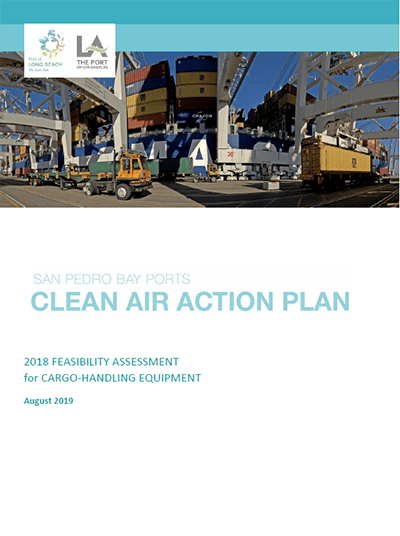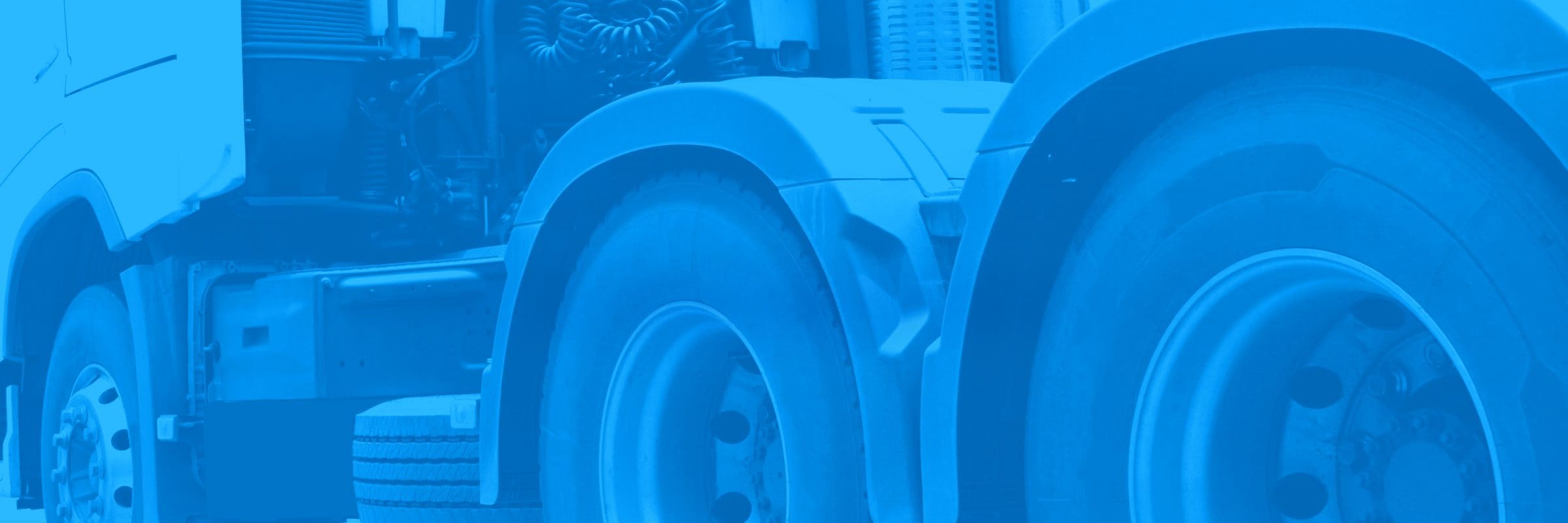
2018 Feasibility Assessment for Cargo-Handling Equipment
Published September 2019
Client: Port of Long Beach, Port of Los Angeles
This 2018 Feasibility Assessment for Cargo-Handling Equipment applied five key parameters to examine which (if any) emerging zero-emission (ZE) and/or near-zero-emission (NZE) fuel-technology platforms for CHE are demonstrably capable of and ready for broad deployment in revenue CHE service at the two Ports, in 2018 or within approximately three years.
Collectively, about 3,500 individual CHE serve the two Ports. Seventy percent (2,447 CHE) are powered by relatively large diesel engines. Heavy-duty diesel engines, in general, emit high levels of key air pollutants. Four types of high-horsepower diesel-powered CHE collectively emit more than 85 percent of the total pollutants from the San Pedro Bay Ports’ collective CHE fleet — and are therefore key targets for reducing emissions under the 2017 CAAP Update. These are:
- Yard tractors
- Top handlers
- Rubber tired gantry (RTG) cranes
- Large-capacity forklifts
Consequently, this 2018 Assessment focuses on the above four CHE types to characterize their overall feasibility for transitioning large numbers to ZE and/or NZE fuel-technology platforms within approximately three years.
Notably, other types of diesel-fueled CHE (e.g., side handlers, reach stackers) also contribute to the Ports’ collective emissions inventories (although their numbers are relatively small). Most are similar (in form and function) to one of the four CHE types listed above (e.g., side handlers are similar to top handlers). Such “other diesel” CHE are not specifically addressed in this Assessment, but they face similar opportunities and challenges for transitioning to ZE and/or NZE platforms.
Additionally, smaller types of CHE – typically powered by non-diesel engines – are targeted for emissions reductions under the CAAP. Small-capacity forklifts powered by gasoline or propane engines are the most prominent examples. Consequently, small-capacity forklifts were also evaluated in this study for their feasibility to use ZE or NZE fuel-technology platforms. This was done separately and at a higher level; full discussion and findings are presented in Section 13 (Appendix C).
Per guidance provided by the Ports, the following five parameters were applied to collectively assess overall feasibility for each of the four key CHE types:
- Commercial Availability
- Technical Viability
- Operational Feasibility
- Availability of infrastructure and Fuel
- Economic Workability (Key Economic Considerations and Issues)
For each of the four CHE types, five core ZE or NZE fuel-technology platforms were initially assessed; these were selected because they are generally cited (by knowledgeable industry, government, and academic representatives) as being the most promising platforms for near-term incorporation into heavy-duty CHE. Moreover, these four CHE types are the subject of ongoing technology development and demonstration programs at the two Ports.
Specifically, the five assessed core fuel-technology platforms were as follows:
- ZE battery electric (charged via manual plugs or inductively) or grid electric (electricity provided directly from the grid via a trench or cable connection)
- ZE hydrogen fuel cell electric (electricity generated onboard by reacting hydrogen and oxygen from air; typically hybridized with a battery pack for peak power and regenerative braking)
- NZE advanced diesel internal combustion engine (ICE)
- NZE advanced natural gas (or propane) ICE
- NZE hybrid-electric (electric drive hybridized with an ICE using any fuel; may or may not include plug-in capability)
Two parameters – commercial availability and technical viability – were used to initially screen the above five core ZE and NZE fuel-technology platforms for their feasibility to power large numbers of CHE as of late-2018 or by 2021. Those fuel-technology platform(s) that were shown to currently achieve (or nearly achieve) the basic considerations for commercial availability and operational feasibility were then further assessed by applying the three remaining feasibility parameters (operational feasibility, infrastructure availability, and economic workability).
Summary of Findings: Screening for Commercial Availability and Technical Viability
As of late-2018, two of the four evaluated CHE types — yard tractors and RTG cranes — offer ZE and/or NZE fuel-technology platforms that simultaneously achieve the basic parameters and criteria to be deemed (or approaching) “commercially available” and “technically viable.” Technical viability is quantified by a Technology Readiness Level score that has reached or is approaching TRL 8.
Specific findings are summarized below for the two types of CHE.
Yard tractors:
- ZE battery-electric technology is commercially offered for yard tractors by multiple OEMs. These are effectively “pre-commercial” or “early commercial” product launches that have achieved TRL 7, and are approaching TRL 8 through focused, multi-unit demonstrations. All four parameters that collectively define commercial feasibility are at least partially achieved.
- NZE natural gas ICE technology is commercially offered for yard tractors by multiple OEMs. These are effectively “pre-commercial” or “early commercial” product launches that have achieved TRL 7, and are approaching TRL 8 through focused, multi-unit demonstrations. All four parameters that collectively define commercial feasibility are at least partially achieved.
- The other three core fuel-technology platforms that were evaluated for yard tractors – ZE fuel cell, NZE hybrid electric, and NZE diesel ICE – do not meet the basic criteria and considerations for commercially availability or technical viability.
RTG cranes:
- ZE grid-electric RTG cranes (new built and conversion packages) are fully commercial products at TRL 9; all four parameters that collectively define commercial availability appear to be fully (or near fully) achieved. Grid-electric RTG cranes receive their electricity from a direct-grid connection (via a cable reel system or busbar) and must maintain that connection for the vast majority of their operation.
- NZE hybrid-electric RTG cranes (new built and conversion packages) are fully commercial products at TRL 9; all four parameters that collectively define commercial availability appear to be fully (or near fully) achieved.
- The other two core fuel-technology platforms that were evaluated for RTG cranes – ZE fuel cell and NZE diesel ICE – do not meet the basic criteria and considerations for commercially availability or technical viability.
The remainder of this 2018 Assessment was focused on further characterizing overall feasibility for yard tractors and RTG cranes powered by the fuel-technology platforms noted above. These combinations of CHE type and fuel-technology platforms were found to simultaneously meet basic criteria and considerations under Commercial Availability and Technical Viability, which were used as screening criteria for further assessment of overall feasibility.
Further assessment consisted of applying individual criteria within the following three major parameters: 1) Operational Feasibility, 2) Infrastructure Availability, and 3) Economic Workability.
Looking Forward: Commercial, Technological and Economic Outlook
As described in this report, most (if not all) CHE OEMs are now developing ZE and/or NZE fuel-technology platforms for their products. To meet CAAP objectives, it is particularly important that OEMs make steady and measurable progress in advancing various ZE CHE platforms towards technological maturity and market readiness. Under the CAAP – as well as state and local air quality plans – large-scale deployments of heavy-duty ZE platforms are expeditiously needed wherever overall feasibility can be established. Yard tractors are key “horizontal” CHE that are making particularly strong and important progress towards the commercialization of ZE architectures. This will help advance efforts by OEMs to incorporate battery-electric and fuel cell platforms into top handlers and large-capacity forklifts. Compared to yard tractors, these larger “vertical” CHE entail new opportunities as well as additional challenges for transitioning to ZE architectures.
As described in this report, the cost-effectiveness of reducing key emissions ($ per mass of reductions) by deploying ZE battery-electric and/or NZE natural gas ICE yard tractors is currently about three to five times higher than the applicable limits under California’s Carl Moyer Program, which serves as a useful metric for comparison. To improve (reduce) cost-effectiveness for the two types of yard tractor architectures, OEMs will likely need to 1) realize significant cost reductions with the onboard energy storage systems they utilize (batteries or natural gas tanks) and/or 2) achieve greater economies of scale through higher-volume manufacturing. Both processes are underway, especially in the case of reducing battery costs for ZE battery-electric tractors. By contrast, ZE and NZE RTG cranes are significantly more cost-effective as a strategy for reducing criteria pollutant and GHG emissions. This is largely because RTG cranes don’t have the same challenges and higher costs associated with energy storage.
Even after commercially viable ZE platforms become available in a given CHE application, it will be an iterative, gradual process to widely transition the applicable San Pedro Bay Port fleet to ZE status. This must be done in close coordination with the building-out of suitable fueling/charging infrastructures. Good progress is underway to accelerate the pace of this transition at the Ports. This can be seen in the many ZE CHE demonstrations that are now, or will soon be, underway at marine terminals serving both Ports.
Related to this expanding number of demonstrations, and equally important, OEM commitment to ZE CHE markets has been growing and strengthening. For even the most challenging CHE applications (e.g., top handlers), CHE OEMs are developing ZE architectures for their products. One major OEM has publicly stated that by 2021, it will make and sell at least one ZE model for all four key CHE types. Ultimately, these products will achieve true commercialization on timelines that are commensurate with commercial maturity and according to what makes good business sense for each OEM.
Over the next three years, it will be very important for OEMs and MTOs, through the many San Pedro Bay Ports demonstrations, to validate these marketing statements and prove that ZE CHE platforms can meet MTO needs for performance, safety, and cost metrics. In tandem, critical infrastructure build-outs will need to move forward in proportion to vehicle rollouts. If these things come to fruition, the commercial availability and broad feasibility of ZE platforms for CHE applications may fundamentally improve at the San Pedro Bay Ports.
